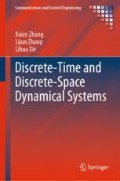Abstract
In this chapter, we introduce basic theoretical tools used throughout the book, that is, graph theory, the semitensor product of matrices, finite automata, and topology. As in the reading flow shown in Fig. 0.1, topology is used to study invertibility (Sect. 3.2) of Boolean control networks and generalized reversibility (Chap. 11) of cellular automata; graph theory is used to characterize nonsingularity (Sect. 3.3) of Boolean control networks, observability (Sect. 4.2) and detectability (Sect. 5.2) of Boolean control networks and large-scale Boolean control networks (Chap. 6); the semitensor product of matrices is used to give an intuitive matrix representation for Boolean control networks (Chap. 3); the theory of finite automata is used to investigate observability (Sect. 4.2) and detectability (Sect. 5.2) of Boolean control networks, observability (Chap. 7) and detectability (Chap. 8) of nondeterministic finite-transition systems, and detectability of finite-state automata (Chap. 9); some existing theoretical results in labeled Petri nets are used to study detectability of labeled Petri nets (Chap. 10).
Access this chapter
Tax calculation will be finalised at checkout
Purchases are for personal use only
References
Cassandras CG, Lafortune S (2010) Introduction to discrete event systems. 2nd edn. Springer Publishing Company, Incorporated, Berlin
Cheng D (2001) Semi-tensor product of matrices and its application to Morgen’s problem. Sci China Ser: Inf Sci 44(3):195–212
Cheng D, Qi H (2009) Controllability and observability of Boolean control networks. Automatica 45(7):1659–1667
Cheng D, Qi H, Li Z (2011) Analysis and control of Boolean networks: a semi-tensor product approach. Springer, London
Cheng D, Yang G, Xi Z (2007) Nonlinear systems possessing linear symmetry. Int J Robust Nonlinear Control 17(1):51–81
Cheng D, Zhang L (2003) On semi-tensor product of matrices and its applications. Acta Math Appl Sin 19(2):219–228
Cheng D, Zhao Y (2011) Identification of Boolean control networks. Automatica 47(4):702–710
Cheng D et al (2016) On decomposed subspaces of finite games. IEEE Trans Autom Control 61(11):3651–3656
Coornaert M (2015) Topological dimension and dynamical systems. Springer International Publishing, Berlin
Čech E (1933) Příspěvek k teorii dimense. Časopis pro pěstování matematiky a fysiky 62(8):277–291
Fornasini E, Valcher ME (2013) Observability, reconstructibility and state observers of Boolean control networks. IEEE Trans Autom Control 58(6):1390–1401
Fornasini E, Valcher ME (2014) Optimal control of Boolean control networks. IEEE Trans Autom Control 59(5):1258–1270
Kari J (2016a) A lecture note on automata and formal languages. http://users.utu.fi/jkari/automata/
Kari J (2016b) Cellular automata. http://users.utu.fi/jkari/ca2016/
Kůrka P (2003) Topological and symbolic dynamics. Société mathématique de France
Li H, Wang Y, Xie L (2015) Output tracking control of Boolean control networks via state feedback: constant reference signal case. Automatica 59:54–59
Li H, Xie L, Wang Y (2016) On robust control invariance of Boolean control networks. Automatica 68:392–396
Li R, Yang M, Chu T (2014) Observability conditions of Boolean control networks. Int J Robust Nonlinear Control 24(17):2711–2723
Lind D, Marcus B (1995) An introduction to symbolic dynamics and coding. Cambridge University Press, New York
Linz P (2006) An introduction to formal language and automata. Jones and Bartlett Publishers Inc, USA
Lu J et al (2016) On pinning controllability of Boolean control networks. IEEE Trans Autom Control 61(6):1658–1663
Qi H et al (2016) Vector space structure of finite evolutionary games and its application to strategy profile convergence. J Syst Sci Complex 29(3):602–628
Ramadge PJ, Wonham WM (1987) Supervisory control of a class of discrete event processes. SIAM J Control Optim 25(1):206–230
Reutenauer C (1990) The mathematics of petri nets. Prentice-Hall Inc, Upper Saddle River
Shu S, Lin F, Ying H (2007) Detectability of discrete event systems. IEEE Trans Autom Control 52(12):2356–2359
Sipser M (1996) Introduction to the theory of computation, 1st edn. International Thomson Publishing, Stamford
Stearns RE, Hartmanis J, Lewis PM (1965) Hierarchies of memory limited computations. In: 6th annual symposium on switching circuit theory and logical design (SWCT 1965), pp 179-190
Wonham WM, Cai K (2019) Supervisory control of discrete-event systems. Springer International Publishing, Berlin
Wu Y, Shen T (2017) Policy iteration algorithm for optimal control of stochastic logical dynamical systems. IEEE Trans Neural Netw Learn Syst 99, 1–6 (2017)
Xu X, Hong Y (2013a) Observability analysis and observer design for finite automata via matrix approach. IET Control Theory Appl 7(12):1609–1615
Xu X, Hong Y (2013b) Solvability and control design for synchronization of Boolean networks. J Syst Sci Complex 26(6):871–885
Zhang K, Zhang L, Su R (2016) A weighted pair graph representation for reconstructibility of Boolean control networks. SIAM J Control Optim 54(6):3040–3060
Zhang K, Zhang L, Xie L (2015) Invertibility and nonsingularity of Boolean control networks. Automatica 60:155–164
Zhang Z, Leifeld T, Zhang P (2017) Identification of Boolean control networks incorporating prior knowledge. In: 2017 IEEE 56th annual conference on decision and control (CDC), pp 5839–5844
Zhao Y, Li Z, Cheng D (2011) Optimal control of logical control networks. IEEE Trans Autom Control 56(8):1766–1776
Zhao Y, Qi H, Cheng D (2010) Input-state incidence matrix of Boolean control networks and its applications. Syst Control Lett 59(12):767–774
Zou Y, Zhu J (2017) Graph theory methods for decomposition w.r.t. outputs of Boolean control networks. J Syst Sci Complex 30(3):519–534
Zou Y, Zhu J (2015) Kalman decomposition for Boolean control networks. Automatica 54:65–71
Author information
Authors and Affiliations
Corresponding author
Rights and permissions
Copyright information
© 2020 Springer Nature Switzerland AG
About this chapter
Cite this chapter
Zhang, K., Zhang, L., Xie, L. (2020). Preliminaries. In: Discrete-Time and Discrete-Space Dynamical Systems. Communications and Control Engineering. Springer, Cham. https://doi.org/10.1007/978-3-030-25972-3_1
Download citation
DOI: https://doi.org/10.1007/978-3-030-25972-3_1
Published:
Publisher Name: Springer, Cham
Print ISBN: 978-3-030-25971-6
Online ISBN: 978-3-030-25972-3
eBook Packages: Intelligent Technologies and RoboticsIntelligent Technologies and Robotics (R0)

